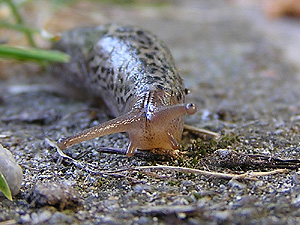
Leopard slug (Limax maximus). Picture: Robert Nordsieck.
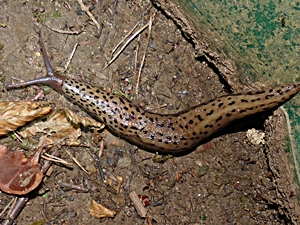
Leopard slug with spots (Limax maximus).
Picture: Martina Eleveld.
Limax maximus Linnaeus 1758
 Leopard slug (Limax maximus). Picture: Robert Nordsieck. |
 Leopard slug with spots (Limax maximus). Picture: Martina Eleveld. |
The leopard slug, also known as the great grey slug, is one of the best-known large domestic slug species, apart from the great black slug (Limax cinereoniger). Its scientific name, Limax maximus, as a matter of fact, is somewhat misleading, since the leopard slug is not the largest (maximus) domestic slug species. That privilege belongs with the great black slug, which can become noticeably larger (ca. 20 cm / 8 in.). Also, the leopard slug wears spots usually only sometimes, mostly it is striped, which is why in German it is called a Tigerschnegel or tiger slug.
![]() Picture: Leopard slug (Limax maximus)
– Colour variations.
Picture: Leopard slug (Limax maximus)
– Colour variations.
Leopard slugs are very interesting creatures. Originating most likely from Southern and Western Europe to Central Europe, the leopard slug here in today's times is established as a synanthropic species or a culture follower. Most species of the Limacidae family, including the leopard slug, are originally forest dwelling slugs, usually feeding on mushrooms, lichen and algae, as well as decaying organic matter (to different extent). The leopard slug is also optionally carnivorous, feeding on other slugs and their eggs, as well.
 Common slug (Arion vulgaris) attacks a passing leopard slug (Limax maximus). Picture: Martina Eleveld. |
As a synanthropic species, the leopard slug today can be found in parks, gardens and graveyards. The German heathland poet Hermann Löns, in his time an established malacologist, has described Limax maximus from Westphalian coal cellars. In the course of modern globalization of trade relations, the leopard slug today has been distributed almost globally, as an introduced species (neozoon) it can be found, in South Africa, North America, Australia, New Zealand and other parts of the world.
At this point, it must be mentioned that the leopard slug, despite appearing mainly in man-made habitats, is not a harmful species. Very much contrary to the common or Lusitanian slug (Arion vulgaris), which it attacks and whose eggs it feeds on. From Norway in the meantime, there are even scientific papers which tried to prove this:
|
|
ěrmen, T.; Winter, B.; B°ckman, P. (2009): En eksperimentell studie av territorial- og predasjonsadferd hos stor kj°lsnegl Limax maximus. Fauna 62(4) 2009: 106-111. (An experimental study of territorial and predation behaviour in the grey slug Limax maximus). |
|
|
|
ěrmen, T.; Winter, B.; B°ckman, P. (2010): Negativ tetthetsavhengighet mellom de skall°se snegleslektene Limax og Arion. Fauna 62(3) 2010 94–99. (Negative correlation between the population densities of the slug genera Limax and Arion). |
The author, as well as Martina Eleveld and Alexander Mrkvicka, have observed this in the field, as well. The picture shows, however, that this goes both ways since leopard slugs sometimes also are attacked by Arion slugs. The effect of leopard slugs regulating other slug species has also been reported by different snail farms, such as the Deutsches Institut für Schneckenzucht in Nersingen near Neu-Ulm, Germany. Leopard slugs are well tolerated in snail farms, since the harmful slugs they regulate, compete for food with the cultivated snails.
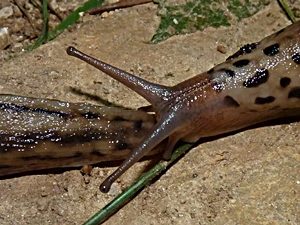 Two leopard slugs (Limax maximus) about to mate, following each other. Picture: Martina Eleveld. |
Apart from its ecological importance, the leopard slug has become well-known for its artistic way of mating. During this, two leopard slugs, meeting by chance, first pursue each other. They follow each other mainly using their sense of smell. What is most interesting apparently is the slime at the tail end of the leading slug.
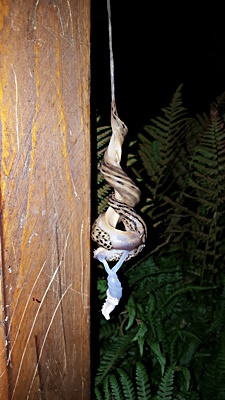 |
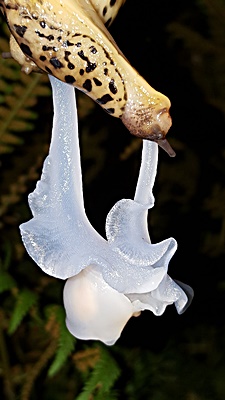 |
||
|
Leopard slugs (Limax maximus) mating. Close-up on the right. Pictures:
Martina Eleveld. |
|||
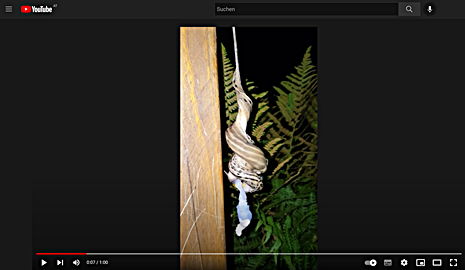 |
|||
|
Leopard slugs (Limax maximus) mating.
YouTube-Playlist. Videos:
Martina Eleveld. |
|||
Both slugs follow each other to an elevated position, like a wall spur or a tree branch. From there, using a self-produced slime rope, they lower themselves up to 40 cm (16 in.) into mid-air to mate. They then extend their penises from behind their heads and interloop them, making a characteristic flower-like structure.
Leopard slugs are hermaphrodites, so in that flower-like structure, they exchange spermatophores, i.e. sperm packets, during copulation.
The leopard slug's mating "stunt" takes place in early summer during the night. It has already been covered by nature documentaries, such as "Life in the Undergrowth" by Sir David Attenborough.
|
|
BBC Worldwide on YouTube: Weird mating calls of the leopard slug: Sir David Attenborough in "Life in the Undergrowth" reports about leopard slugs mating. |
During mating, but also when a leopard slug is upset by being sprayed with water, it might lift the lateral parts of its mantle shield like wings, probably to deter enemies.
After the conclusion of the mating process, one leopard slug will let itself fall to the ground, while the other climbs the slime rope to the top, sometimes eating it in the process. This can well be seen in the picture series by Martina Eleveld, as well as in her videos on our YouTube channel.
![]() Leopard slugs (Limax maximus) mating.
Picture series with explanations. Pictures:
Martina Eleveld.
Leopard slugs (Limax maximus) mating.
Picture series with explanations. Pictures:
Martina Eleveld.
![]() Leopard slugs (Limax maximus) mating. Playlist on YouTube. Videos:
Martina Eleveld.
Leopard slugs (Limax maximus) mating. Playlist on YouTube. Videos:
Martina Eleveld.
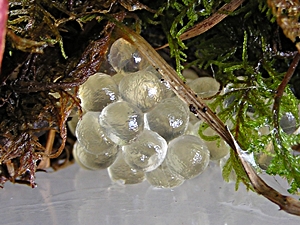 A leopard slug's (Limax maximus) eggs. Picture: Clemens M. Brandstetter (Quelle: Wikipedia) |
Contrary to Arion slugs, the leopard slug is perennial: it hibernates and can live up to two and a half years. After their artistic mating procedure, leopard snails lay up to 200 large eggs. Those are translucent, so the young slugs' development can well be observed. The freshly hatched young slugs are tiny and pale white. It is not until some time later that they get their first stripes and spots.
Leopard slugs can be kept in a terrarium with some effort. While they might attack other slugs in the wild, according to different observations such as by Clemens M. Brandstetter, an Austrian slug specialist, if kept in a terrarium of sufficient size, they are usually quite sociable, only cannibalistic to an insignificant extent, and will hardly attack each other. What is also worth remarking is that leopard slugs apparently show no significant aggression towards their young, which usually simply crawl over the adults and have them carry them around. In the wild, several leopard slugs will hide beneath the same piece of tree bark, we have numerous times found several of them on one tree stump which does not seem to constitute a problem.
Because of leopard slugs' special method of mating, a terrarium for this species should have a sufficient height, and also provide branches to climb and to lower down from to mate. So, the mating of leopard slugs in captivity is possible, albeit not exactly easy. However, cultivating leopard slugs in captivity, to the author's knowledge, has never been achieved.
Though the leopard slug's scientific name, Limax maximus, originates from Carl v. LinnÚ and as such is among the oldest valid scientific names, the species' scientific classification has long been unclear, especially its systematic separation from the great black slug (Limax cinereoniger) has been very unclear and difficult to determine for a long time. A clear anatomical distinction only took place by the mid-19th century and a biological or more precisely a sexual biological distinction did not take place until the 1930s. Even in the 1980s, the distinction between Limax maximus and Limax cinereoniger has been assessed as "unclear" (Wiktor, 1983). Finally, in a paper by the malacologists T. v. Proschwitz and G. Falkner (2007), Limax maximus was given a lectotype from Yorkshire in England, which is as close as possible to the original description by LinnÚ (based on an earlier one by Lister from 1685).
![]() Von
Proschwitz, T.; Falkner,
G. (2007): Limax maximus Linnaeus
1758: Die problematische Identität einer vermeintlich gut bekannten Art
(Gastropoda: Limacidae). Heldia 5 (3): 89 - 98. (In German: The problematic
identity of a presumably well know species).
Von
Proschwitz, T.; Falkner,
G. (2007): Limax maximus Linnaeus
1758: Die problematische Identität einer vermeintlich gut bekannten Art
(Gastropoda: Limacidae). Heldia 5 (3): 89 - 98. (In German: The problematic
identity of a presumably well know species).
![]() Leopard slug from Yorkshire:
Pictures of a leopard slug from Swinsty, Yorkshire (Limax maximus) by
Ken Wood. Yorkshire is the species' locus typicus.
Leopard slug from Yorkshire:
Pictures of a leopard slug from Swinsty, Yorkshire (Limax maximus) by
Ken Wood. Yorkshire is the species' locus typicus.
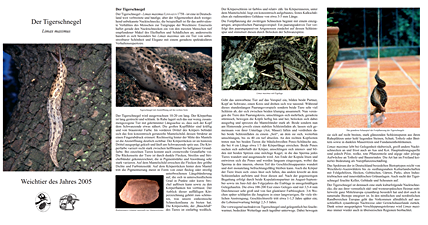 Weichtier des Jahres: Der Tigerschnegel. (Mollusc of the year: The leopard slug). |
In 2005, The board of trustees "Mollusc of the Year" chose the leopard slug as mollusc of the year and published a factsheet about this interesting species. A quote from this factsheet describes the leopard slug very well: "On the one hand, slugs, in general, are especially stuck with the taint of the disgusting and harmful; on the other, Limax maximus especially is a creature of undisputable beauty and elegance with a downright spectacular repertoire of behaviour.".
There is little to add to that.